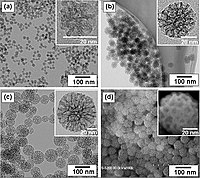
Photo from wikipedia
Copper nanoparticles were produced by a chemical metallurgical method and by the thermal decomposition of copper citrate and formate. It was shown that the copper nanopowder obtained from copper citrate… Click to show full abstract
Copper nanoparticles were produced by a chemical metallurgical method and by the thermal decomposition of copper citrate and formate. It was shown that the copper nanopowder obtained from copper citrate is not pyrophoric. Combustion of this copper nanopowder can be initiated by an external source, and the combustion wave velocity is 1.3 ± 0.3 mm/s. The specific surface area (45 ± 5 m2/g) of the copper nanopowder obtained from copper citrate is almost four times as large as that of the nanopowder produced by a chemical metallurgical method. The former nanopowder contains almost no oxides and is stable in atmospheric air, whereas the latter nanopowder is pyrophoric and, therefore, requires passivation, but its passivation gives rise to noticeable amounts of copper oxides. The combustion velocities of the passivated and unpassivated copper nanopowders are almost equal and are 0.3 ± 0.04 mm/s. The dynamics of the temperature fields in ignition and combustion of the copper nanopowders obtained by different methods was studied.
Journal Title: Doklady Chemistry
Year Published: 2018
Link to full text (if available)
Share on Social Media: Sign Up to like & get
recommendations!